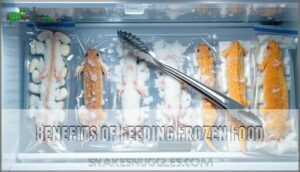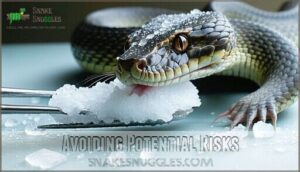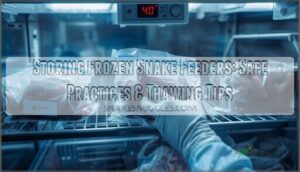This site is supported by our readers. We may earn a commission, at no cost to you, if you purchase through links.

Place the frozen rodent in a sealed plastic bag, then submerge it in warm water for 30-60 minutes until it reaches room temperature.
Don’t use a microwave, as it creates hot spots that can burn your snake’s mouth.
Once thawed, use feeding tongs to present the prey, moving it slightly to trigger your snake’s hunting instincts.
The prey should feel warm but not hot when you touch it.
Many snakes accept frozen food readily, though some stubborn eaters need patience and specific techniques to make the switch successfully, and it’s essential to ensure a smooth transition to frozen food.
Table Of Contents
- Key Takeaways
- Frozen Vs. Live Feeding
- Benefits of Feeding Frozen Food
- Transitioning to Frozen Food
- Thawing Frozen Prey
- Safe Types of Frozen Food
- Feeding Frequency and Portions
- Avoiding Potential Risks
- Techniques to Enhance Food Appeal
- Teaching a Snake to Eat Frozen Food
- Reducing Stress During Feeding
- Frequently Asked Questions (FAQs)
- Can snakes eat frozen food?
- Can you feed a snake a frozen rodent?
- How do you feed a snake if it doesn’t want to eat?
- Do snakes need a lot of food?
- How do snakes change their diet?
- Can You thaw frozen snake food?
- How to feed a snake frozen?
- Do snakes eat frozen food?
- How to heat up frozen mouse for snake?
- How long does it take to defrost snake food?
- Conclusion
Key Takeaways
- Thaw frozen prey properly – You’ll need to place the rodent in a sealed bag and submerge it in warm water for 30-60 minutes until it reaches room temperature, never using a microwave, which creates dangerous hot spots.
- Use feeding tongs and movement – You should present the prey with tongs and move it slightly to trigger your snake’s hunting instincts, making the frozen food more appealing and safer for feeding.
- Be patient during the transition – Your snake might refuse frozen food initially, but do not panic – most snakes adapt within days to weeks with consistent offering and proper scenting techniques.
- Prioritize safety over convenience – Frozen prey eliminates bite risks to your snake, costs less than live feeding, and provides the same nutritional value while being easier to store long-term.
Frozen Vs. Live Feeding
Many snake owners wrestle with choosing between live prey and frozen prey for their pets.
Live feeding carries handling risks and ethical considerations, while prekilled prey offers safer snake feeding with identical nutritional differences.
Frozen prey eliminates bite risks while delivering the same nutrition your snake needs to thrive.
Frozen options cost less, store longer, and eliminate bite injuries to your snake.
Most snakes adapt to feeding frozen snakes meals without losing their natural hunting instincts.
Benefits of Feeding Frozen Food
Frozen prey offers several key advantages over live feeding, including improved safety for both you and your snake, consistent nutritional value, and easier storage.
You’ll find that frozen food eliminates the risk of prey bites, reduces stress during feeding time, and provides better control over your snake’s diet while being more cost-effective in the long run, with consistent nutritional value.
Thawing Techniques
Proper thawing keeps your snake healthy and satisfied. Refrigerator thawing works best—place frozen rodents in a sealed bag overnight.
For faster results, try cold water speed thawing by submerging the bagged prey for 30-60 minutes. For specialized tools, consider exploring options for rodent thawing equipment.
Never use microwaves, as they create hot spots that harm your snake. The thawing duration depends on prey size—mice need less time than rats.
Always make certain frozen prey reaches room temperature before feeding.
Enhancing Food Appeal
Once you’ve got thawing down pat, it’s time to make that frozen meal absolutely irresistible.
Your snake might need some convincing, but these scenting techniques will do the trick:
- Scent stimulation through braining: Puncture the prey’s brain to release natural blood scents that trigger feeding responses.
- Broth thawing method: Thaw prey in chicken broth instead of plain water for added aroma and flavor enhancement.
- Color variety appeal: Offer different colored prey items to spark visual interest and mimic natural hunting scenarios.
- Mimic movement patterns: Use feeding tongs to create lifelike prey movements that activate your snake’s predatory instincts.
Reducing Stress
Creating secure enclosures with ample hiding places substantially reduces snake stress during frozen food feeding.
Cover the enclosure with a sheet to minimize visual disturbances while your snake adjusts. Establish a consistent feeding schedule and reduce handling for several days beforehand.
Practice gradual introduction of new thawing techniques rather than rushing the process. These stress reduction methods improve feeding success rates considerably.
Transitioning to Frozen Food
Your snake’s initial refusal of frozen snake food doesn’t mean failure.
Don’t let your snake’s first "no" discourage you—persistence pays off in the frozen feeding journey.
Switching from live prey to frozen rodents requires patience and strategy.
Start with gradual introduction techniques, offering frozenthawed food alongside familiar live alternatives.
During hunger strikes, avoid panicking—snakes can fast for weeks safely.
Frozen food offers convenience and cost-effectiveness, making it a practical choice for snake owners.
Consider these proven methods for successful snake feeding switches:
- Scent training: Rub frozen prey with lizard or frog scent to trigger feeding responses
- Overnight offerings: Leave thawed rodents in the enclosure when you’re not watching
- Movement mimicry: Use tongs to simulate live prey behavior and encourage strikes
- Brain exposure: Puncture the skull to release appealing blood scents for stubborn feeders
Thawing Frozen Prey
Mastering the thawing process guarantees your snake gets safe, nutritious meals every time. Follow these essential steps to transform frozen rodents into appealing prey.
- Secure bagging: Place frozen snake food in a sealed plastic bag to prevent contamination and contain any mess during the thawing process.
- Refrigerator method: Thaw frozen rodents overnight in the refrigerator for complete, even thawing. This technique maintains safe temperatures and prevents bacterial growth that can harm your snake.
- Cold water acceleration: Speed up thawing by submerging the bagged rodent in cold water for 30-60 minutes. Change water as needed to maintain consistent thawing duration.
- Temperature verification: Check that frozen-thawed rodents reach room temperature before feeding. Use your hands or a thermometer to confirm complete thawing throughout the prey item.
Never refreeze thawed prey due to refreezing dangers and bacterial contamination risks. Avoid microwaving or using hot water, as these methods can partially cook the rodent and create unsafe internal temperatures for your snake.
For rodent thawing supplies, specialized retailers offer a variety of options.
Safe Types of Frozen Food
When choosing frozen food for your snake, prey size matters most—select rodents matching your snake’s thickest body part.
Frozen mice and frozen rats from ethical sourcing provide excellent nutritional value. Stick to naturally-colored prey rather than artificially dyed options.
Rodent variety keeps meals interesting while ensuring balanced nutrition. Choose untreated, chemical-free frozen rodents to avoid harmful additives.
Consider scenting options if your snake seems picky. Commercial suppliers offer quality-controlled frozen prey that’s safer than live alternatives, with consistent sizing and parasite-free guarantee.
It’s important to use proper defrosting techniques to minimize bacterial risks.
Feeding Frequency and Portions
Getting your frozen food selection right means nothing without proper feeding frequency and portion control.
Age factors play a huge role here.
Hatchlings need meals every 5-7 days, while adults can wait 10-14 days between feedings.
Snake metabolism slows substantially with maturity.
Prey size matters just as much as timing.
The rodent’s width shouldn’t exceed your snake’s thickest body part.
Going too large creates regurgitation risks and digestive stress.
Too small means inadequate nutrition.
Snake feeding portions should create a visible bulge that disappears within 24-48 hours.
Consistent snake feeding sizes prevent obesity prevention issues while maintaining healthy growth patterns.
For unsure owners, it’s safer to offer appropriately smaller prey than oversized ones.
Avoiding Potential Risks
Before diving into frozen feeding, understanding potential hazards protects both you and your snake.
Bacterial contamination from improperly thawed frozen rodents poses serious health risks, while temperature concerns can shock your snake’s digestive system.
Following proper handling precautions prevents accidents during feeding time.
Here are key risks to avoid:
- Bacterial contamination from refreezing thawed prey or improper storage
- Impaction risks from oversized prey or substrate ingestion during feeding
- Nutritional deficiencies from expired or freezer-burned rodents
- Temperature concerns when prey isn’t properly warmed before offering
- Handling precautions requiring tongs to prevent bites during strikes
Techniques to Enhance Food Appeal
When your snake turns its nose up at frozen prey, these four proven techniques will spark their appetite:
- Scenting Techniques: Dip thawed rodents in sodium-free chicken broth or rub with lizard scent to trigger natural feeding responses. To further entice picky eaters, consider using products with lizard scent.
- Braining Prey: Expose brain tissue by making a small puncture—this releases irresistible scents that activate hunting instincts.
- Movement Mimicry: Dangle prey slightly to the side of your snake’s head, mimicking live prey behavior.
- Color Variation: Switch feeder colors occasionally to maintain interest and curiosity.
Teaching a Snake to Eat Frozen Food
When your snake shows initial refusal to frozen food, don’t panic—this behavior’s completely normal. Start your gradual shift by offering pre-killed prey that’s still warm, which bridges the gap between live and frozen options.
Proper thawing frozen snake food to room temperature is vital for acceptance. Scenting techniques work wonders for reluctant eaters. Rub the frozen rodent with lizard skin or frog scent to trigger natural hunting instincts.
Live mimicry helps too—use feeding tongs to create realistic movement patterns that activate your snake’s predatory response. Patience training is key during this process.
Some snakes adapt within days, while others need weeks of consistent feeding frozen rodents. Maintain your regular feeding schedule and avoid switching back to live prey, which can reset your progress completely.
Reducing Stress During Feeding
Once your snake’s mastered frozen food, creating a calm feeding environment becomes your next priority.
Stress can disrupt your snake’s appetite and digestion, so implementing proper handling techniques makes all the difference.
Here’s how to minimize feeding stress:
- Secure enclosure setup: Cover the habitat during meals to create privacy and reduce visual distractions
- Strategic hiding spots: Add extra cover so your snake feels protected while eating
- Consistent feeding schedule: Stick to regular intervals, typically once weekly for most species
- Extended observation period: Monitor from a distance to assess snake behavior without interference
- Proper frozen food preparation: Make certain prey’s thoroughly thawed and warmed to reduce rejection
Frequently Asked Questions (FAQs)
Can snakes eat frozen food?
Ironically, while snakes are cold-blooded, they can’t eat frozen food directly. You’ll need to thaw and warm frozen prey first, making it safe and appealing for your snake’s digestion.
Can you feed a snake a frozen rodent?
You can’t feed snakes frozen rodents directly. They must be completely thawed first, then warmed to room temperature. Frozen prey causes digestive problems and health risks for your snake.
How do you feed a snake if it doesn’t want to eat?
Try moving your snake to a smaller, quieter enclosure with hiding spots.
Cover it with a sheet, then offer scented prey using tongs with gentle movement.
If unsuccessful, wait several days before attempting again.
Do snakes need a lot of food?
No, snakes don’t need frequent meals. Most adult snakes eat once every seven days, while some larger species can go weeks between feedings. They’re efficient eaters with slow metabolisms.
How do snakes change their diet?
Like shifting gears in a car, snakes naturally adjust their diet as they grow.
You’ll see them progress from tiny pinky mice to larger prey, with adult snakes eventually consuming rats or even guinea pigs.
Can You thaw frozen snake food?
Yes, you can thaw frozen snake food safely.
Place it in a sealed bag and refrigerate overnight, or submerge in cold water for faster thawing.
Never use hot water or microwaves.
How to feed a snake frozen?
First, thaw frozen rodents overnight in your refrigerator. Warm them in hot water for 10-20 minutes, then use tongs to offer the prey to your snake immediately.
Do snakes eat frozen food?
Picture a snake’s primal instinct kicking in as it detects prey.
Yes, snakes readily eat frozen food once it’s properly thawed and warmed.
You’ll find most captive snakes prefer this safe, convenient feeding method over live prey, as it aligns with their natural behavior and primal instinct.
How to heat up frozen mouse for snake?
Thaw your frozen mouse in the refrigerator overnight, then place it in a sealed bag and submerge in warm water (100-110°F) for 10-20 minutes until it reaches room temperature.
How long does it take to defrost snake food?
Time’s ticking when your snake’s hungry, but patience pays off.
You’ll need overnight refrigerator thawing for frozen rodents, typically 8-12 hours.
Cold water speeds things up to 30-60 minutes if you’re pressed for time.
Conclusion
Mastering how to feed a snake frozen food isn’t rocket science, though your snake might initially act like you’re serving yesterday’s leftovers.
With proper thawing techniques, feeding tongs, and patience, you’ll successfully switch your serpent to safer frozen prey.
Remember to warm the food thoroughly, use gentle movements to trigger hunting instincts, and don’t rush stubborn eaters.
Your snake’s health and your peace of mind make this feeding method worth the effort.
- https://www.zenhabitats.com/blogs/reptile-care-sheets-resources/corn-snake-complete-food-guide?srsltid=AfmBOopEf29BdhWI1NA82P82x6HvmqrP--wEiGOwD0eRtfgakzP0QcU1
- https://reptifiles.com/corn-snake-care-guide/corn-snake-food/
- https://www.dvm360.com/view/current-thoughts-reptile-nutrition-proceedings
- https://www.msdvetmanual.com/management-and-nutrition/nutrition-exotic-and-zoo-animals/nutrition-in-reptiles
- https://rethinkpriorities.org/research-area/rodents-farmed-for-pet-snake-food/













